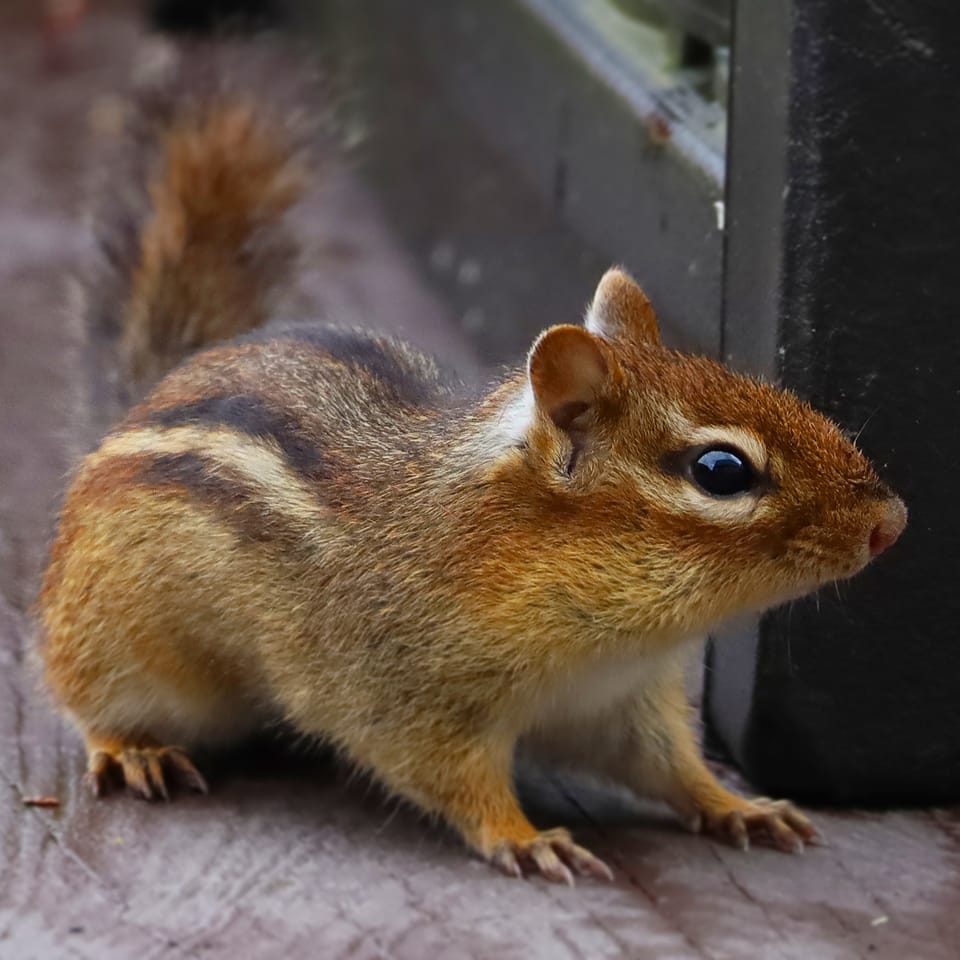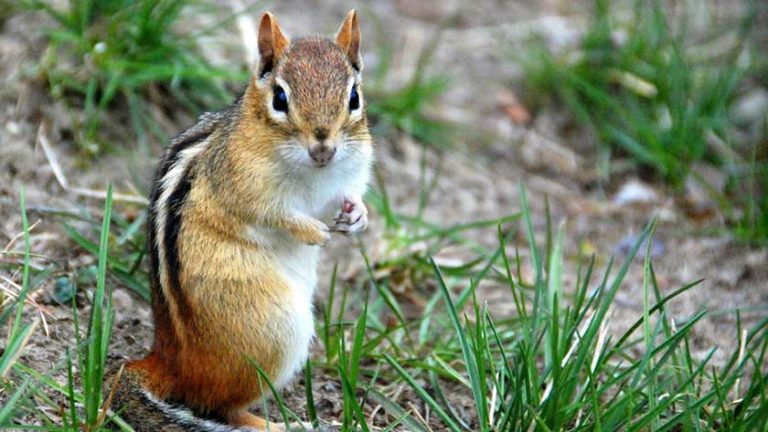You have likely seen a chipmunk scurrying across the ground or climbing trees and even enjoyed their presence. This is especially since they are super cute rodents with compact slender bodies. However, you will feel differently if they invade your yard.
Don’t let their adorable tiny bodies fool you into thinking they are harmless. Chipmunks are highly energetic, agile, skilled diggers who create intricate burrow systems underground.
So, you must learn how to get rid of chipmunks in your yard
How Do You Know If You Have A Chipmunk Problem?

Since chipmunks are quick, shy rodents, seeing them in your yard may be challenging until they cause destruction.
Therefore, what signs should you look for to inform you of their presence in your yard?
1. Physical Sightings
Regular sightings of chipmunks in your yard or around your property indicate a chipmunk problem. This often happens during the day, especially in the early morning or late afternoon, because these rodents are diurnal creatures.
So, you have seen chipmunks in your yard, but how can you be sure they are chipmunks and not other similar-looking rodents like prairie dogs?
Chipmunks are about 5 to 6 inches long, not including their tails. They have distinct stripes running down their backs, typically alternating dark and light colors.
Also, their expandable cheek pouches are distinctive.
2. Holes and burrows
They may be tiny, but when chipmunks go to work, they utilize their burrowing skills to create underground tunnels and chambers for nesting and storing food.
Chipmunk burrows usually have a single about 1.5 to 2 inches diameter entrance hole. You will often find this hole at the base of a tree, near a rock, or against a structure like a wall or foundation.
Also Read:
- How To Get Rid Of Raccoons In Your Yard
- How to get rid of woodchucks in yard
- Lots of small holes in lawn
The entrance hole might also have a small pile of loose soil or dirt. However, unlike other burrowing animals like moles, chipmunks keep the area around their burrows relatively clean, so you might not see much debris scattered around the entrance.
Regarding depth, Chipmunk burrows can extend several feet below the ground’s surface, offering protection from predators and harsh weather conditions.
3. Plants and Vegetation Damage
Do you have flowers, fruits, vegetables, nuts, seeds, bulbs, and other plants growing in your yard? Chipmunks will enjoy feeding on them if they enter your yard and leave evidence of their destruction behind.
For instance, Chipmunks’ distinctive sharp teeth will leave behind clean-cut bite marks on leaves, flowers, and fruits growing close to the ground. Also, they nibble on plants, resulting in missing parts, such as partially eaten fruits or flowers.
You may also notice that seeds from bird feeders or your garden have disappeared since these small rodents collect and store seeds in their burrows. Furthermore, your potted plants and planters may suffer harm from chipmunks digging into them, searching for food, or burying seeds.
Sometimes, chipmunks can chew on the bark of young trees or shrubs.
4. Chipmunk Sounds
Chipmunks communicate with each other and respond to the environment through vocalizations and sounds. So, listen for high-pitched chirping sounds, repetitive and rapid chattering, trilling, squeaking or squealing, and mating call sounds.
5. Scattered Shells and Seeds
Those adorable cheek pouches of chipmunks are not there for aesthetics; they serve the vital function of collecting and carrying food back to their burrows for storage.
Apart from gathering them, chipmunks consume nuts like acorns, hickory nuts, and other seeds, then discard the shells in small piles near their burrows or feeding areas after gnawing through the hard outer shell.
6. Tunnels Under Your Bird Feeders
If you see tunnels under your bird feeders, chances are chipmunks made them in order to collect spilled seeds.
7. Nesting Materials
Chipmunks build nests for their young ones using various materials like leaves, grass, soft plant stems, moss, feathers, animal hair, and fur. The nests are often located underground in burrows, but you may see fresh nesting materials around the burrow entrance.
8. Chewed Electrical Wires or Cables
This is rare, but chipmunks can gnaw on electrical wires and cables.
Ways To Get Rid Of Chipmunks In Your Yard

After observing your yard and realizing that you have chipmunks living there, the next step is to get rid of them. The upside is that you don’t have to harm them. Below are the viable methods.
1) Use Chipmunks Repellents
There are many ways to repel chipmunks, commercial and natural. Consider the following:
1. Use Hot pepper spray
Capsaicin’s strong smell and taste will deter chipmunks. Therefore, create a homemade chipmunk repellent spray by mixing water and hot pepper flakes or hot sauce, then apply the mixture to plants or areas you want to protect. Reapply after watering or rain.
2. Garlic spray
Use the smell of garlic against chipmunks by mixing water and crushed garlic cloves to make a garlic spray. Spray garlic on your plants or around chipmunks’ active spots.
3. Commercial repellents
There are various commercial chipmunk repellent products available, such as granules, sprays, or ultrasonic devices.
4. Mothballs
While you can deter chipmunks with mothballs, I would advise against it if you have pets because they contain chemicals that can harm humans and pets. Place mothballs in a breathable container and position them strategically near chipmunk activity areas if you decide to use them.
5. Predator urine
The scent of a potential predator, like foxes or coyotes, can make chipmunks feel unsafe, causing them to avoid the area.
Note
Consider planting mint, garlic, marigolds, onions, or daffodils around the edges of your garden to create a natural deterrent against chipmunks. Sprinkling diatomaceous earth around plants or areas can also create a barrier that chipmunks find irritating to walk across.
2) Remove Food Sources
As opportunistic feeders, chipmunks will come to your yard if it offers food, shelter, and water. Therefore, eliminating food sources is one of the surest ways to make your lawn unwelcoming to chipmunks.
Ensure your bird feeders minimize spillage, and consider hanging feeders on poles with baffles to make them difficult for chipmunks to reach.
Also, regularly remove fallen fruits, nuts, and seeds from the ground to eliminate potential food sources. Furthermore, secure your garbage bins to keep chipmunks from rummaging through them.
3) Install Barriers
Protect specific areas of your yard, mainly those with plants from chipmunks, by installing barriers. However, what kind of barriers will keep chipmunks out?
Fine mesh, chicken mesh, or hardware cloth fencing around garden beds, shrubs, or flower beds creates a physical barrier that chipmunks cannot easily climb or burrow under. Bury the wire about 6 inches below the ground to prevent chipmunks from digging under it.
What about fruit or bird feeders on trees? Keep them off-limits to chipmunks by wrapping tree trunks with metal or plastic tree wraps.
Raised garden beds with barriers around the base will protect your plants. On the other hand, hardware cloth or plastic cylindrical collars around the base of young trees or shrubs protect them from chipmunk gnawing.
4) Humane Trapping
Are you dealing with a huge chipmunk infestation? Use humane trapping to eliminate them and have your yard all to yourself again. Find a live trap for small rodents and a chipmunk-friendly bait, such as seeds, nuts, or peanut butter, to attract them.
Place the live traps in areas where you’ve seen chipmunk activity or near their burrow entrances and check them regularly. Once you’ve captured a chipmunk, transport it to a suitable wooded area far away from your property (at least a few miles) and release it.
5) Motion-Activated Devices
Another way to deter chipmunks is by installing motion-activated sprinklers that release a burst of water when the animal crosses the sensor’s path, scaring them away. Alternatively, go for an ultrasonic repellent that emits high-frequency sound waves unpleasant to chipmunks and other rodents but usually inaudible to humans and most pets.
6) Keep Your Yard Clean
A clean and well-maintained yard reduces the availability of food and shelter for chipmunks, making your property less attractive to these small rodents. However, how do you keep your yard clean?
- Regularly sweep or rake fallen fruits, nuts, and seeds from the ground to minimize the available food for chipmunks.
- If you have outdoor pets, do not leave their food bowls outside, and store pet food in sealed containers to prevent chipmunks from accessing it.
- Clear away brush piles, leaf piles, and other debris from your yard, as chipmunks may use these as hiding spots or nest sites.
- Trim shrubs and tree branches, especially those near your house, because they will provide chipmunks with a pathway to your property.
- If you have outdoor dining areas, clean up food spills promptly because chipmunks will gladly feed on your leftovers and spills.
- Keep an eye out for chipmunk burrows in your yard and garden. If you spot any, consider using barriers to prevent chipmunks from digging new holes.
Final Remarks
You are better off enjoying these adorable little rodents from afar, away from your yard. If you let them be, they can dig long, deep burrows in your lawn and destroy your plants by eating them. Therefore, use the methods above to eliminate them once you confirm their presence.

Hey there, I’m Derek Schew, a writer for Lawnholic.com, where we cover everything and anything related to lawns. As someone who’s spent countless hours tending to my own lawn, I’m passionate about sharing my knowledge and helping others achieve the perfect yard. From lawn care tips to product reviews, I’m committed to providing our readers with the most accurate and up-to-date information available. So whether you’re a seasoned lawn enthusiast or just getting started, I invite you to join our community and discover the joys of a lush, green lawn.
